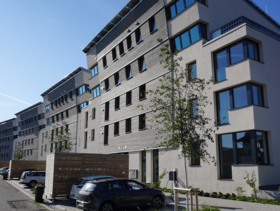Residential complex in Buckenhof
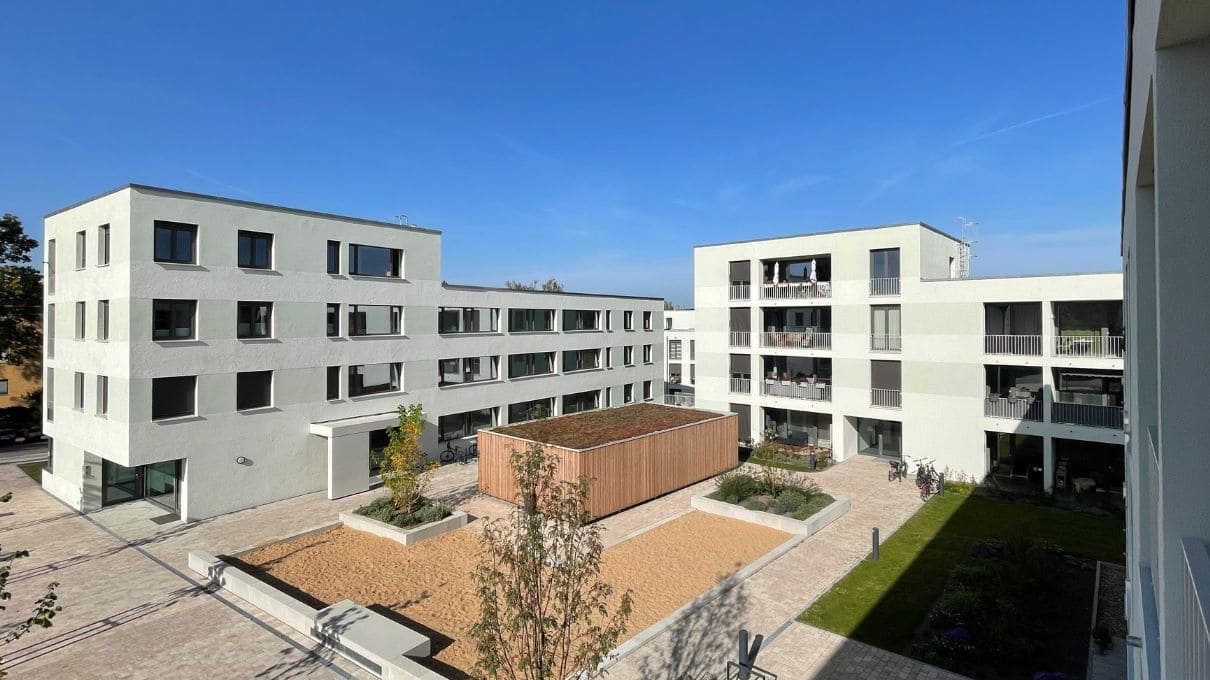
Comfort ventilation as part of a sustainable heat concept
The new “CampusRo” is a pioneering student accommodation project built on the Rosenheim campus which was established in 1971. Multi award-winning, environmentally friendly, smart and high-quality, it provides lots of space for modern interaction and community activities. The buildings are of a sustainable wood / hybrid construction built to the KfW 40 plus standard. The HVAC system includes a comfort ventilation system from Meltem.
Ground-breaking environmental standard
Architect Michael Gebhard grouped the three residential blocks with the rental apartments in a natural setting on the edge of town, surrounding a central public space intended to act as a neighbourhood meeting place. Adjacent to this is the assisted living building. The objective for the entire project was to achieve an ambitious environmental standard in addition to providing affordable homes.
The building was designed and implemented as a passive energy house as defined in DIN 18599. This ensures that the energy required for heating does not exceed 15 kWh/m² living space per year or 10 W/m² for the peak demand. The total energy consumption per year will not exceed 60 kWh/m². The choice of construction materials and the way it is operated make the entire residential complex future-oriented. This is further reflected in the choice of energy concept and the installed building services:
Heat is supplied by geothermal energy; multiple holes were drilled in the ground to a depth of 100 metres. A total of 24 geothermal probes supply heat to the complex. A photovoltaic system was installed to generate renewable electricity. The current obtained from this is used to operate the heat pump. The overall concept also includes a public/private charging structure for electric vehicles, supplemented with a car sharing arrangement. Finally, the sustainable energy concept incorporates the installation of comfort ventilation units with heat recovery.
Structural physics and financial benefits
The energy concept and all the technical planning for the building (and the construction management) were developed by the Joseph Foundation’s own team – Planung HLS. Under the Passivhaus standard the building envelope is very air tight (with an air renewal of less than 0.6/h at a pressure of 50 Pascals), so ventilation systems with heat recovery conforming to DIN 1946-6 were installed. Especially in modern, highly insulated buildings it is important to ensure the necessary replacement of the air inside the building. This ensures that the excess moisture in the air – which inevitably builds up in the rooms – is continuously moved to the outside. If this does not happen, the walls and ceiling are at risk of moisture damage and mould formation. The decision was therefore taken to install a decentralised ventilation system from Meltem (type M-WRG-II E and installation version U2). The benefit is obvious. The multi-room variant of this comfort ventilation system allows air to be drawn into and removed from several rooms at the same time. So, for example, the 2-room apartments with internal bathroom only require one ventilation unit.
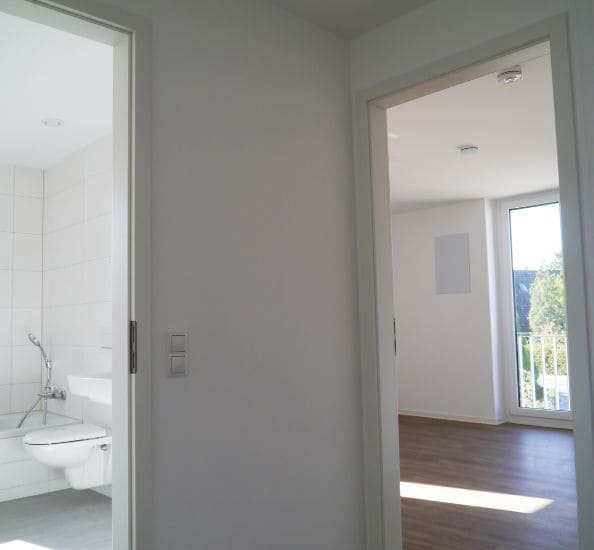
High comfort
Meltem’s M-WRG-II E ventilation units can increase living comfort and promote wellness inside enclosed rooms. Odours are also reliably removed. In cold weather periods, the used, warm ambient air is extracted and routed via an enthalpy cross-counterflow heat exchanger. In this process, the heat is extracted from the air and is then transferred to the outdoor air which is supplied separately. Up to 87 % of the heat can be recovered in this way. At the same time, some of the humidity from the extract air is fed back to the room air.
Moisture recovery from the extract air is based on the principle of osmosis. The water molecules pass through an antimicrobial polymer membrane, driven by the moisture’s concentration gradient from the warm air to the cold air side. The membrane film acts as a separating layer for the air flows and guarantees that only water vapour from the two air flows adjacent to the membrane is transferred.
Microbes, mould fungi and bacteria are larger than water molecules so they are unable to penetrate and settle in the membrane. The heat exchanger with polymer membrane is tested to and compliant with the hygiene requirements of VDI 6022 sheet 1. The enthalpy function effectively prevents the air we breathe being too dry in the winter and prevents excessive atmospheric humidity in the summer. This has a positive effect on the atmosphere in the room, especially during periods of cold weather, since the air does not dry out excessively.
The other benefits of the M-WRG-II E ventilation units include increased living comfort since the air temperature always remains constant, plus reduced heating costs. And there are no uncomfortable drafts, in contrast to ventilation through the window.
The uniform ventilation also ensures that pollutants in the air – emissions, CO2, mites and mould spores – are removed. Even hay fever sufferers can breathe easily since all the units are fitted with a fine particulate filter (ISO ePM1 60% (F7)) for the outdoor air as standard. The fine filter medium effectively retains respirable dust particles such as pollen, soot and bacteria from dust class PM1. There is also a special activated charcoal filter available on request; this absorbs the odours of harmful gases, nitrogen oxides and ozone.
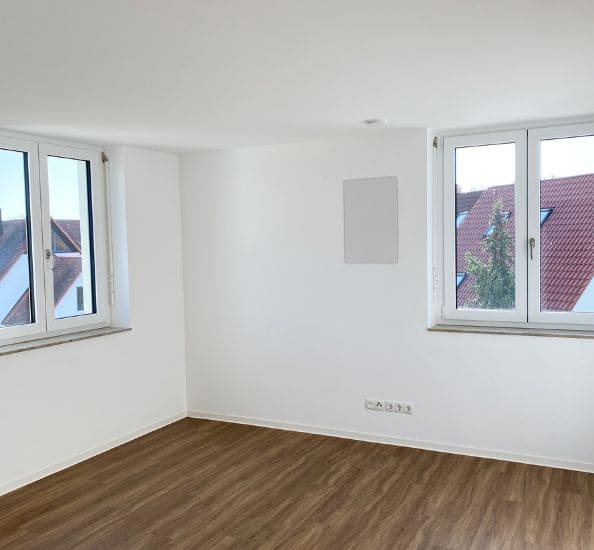
Continuous fresh air
Installation of an automatic ventilation system makes absolute sense in buildings in which the residents are unable to ensure regular air renewal themselves, as is the case in a senior care home, for example. A total of 74 M-WRG-II E units were used in the Buckenhof residential complex. These were integrated into the wall beside the windows. The installation location was specially selected to be as unobtrusive as possible.
Clever and practically invisible
In the individual residential units at Buckenhof, it was important to ensure a supply of air to and from the living space and bathroom. The multi-room solution from Meltem allowed the number of ventilation units needed to be kept to a minimum. For example, apartments with two rooms and internal bathroom could be ventilated with a single M-WRG-II unit. In these roughly 58 m² residential units, the ventilation unit was installed in the living area. Flexible pipes and ceiling valves extract the air from the internal bathroom, supplying the living room and bedroom with air at the same time.
Two units were needed for the 3 and 4-room apartments. Again, one was installed in the living area and the other in a storage room. For the multi-room solution, it is important to have an interconnected air system between the different rooms; this can be achieved by means of non-closing overflow openings in or beneath the doors.
These solutions can be used for a variety of new build and renovation projects; in addition to the senior care home illustrated here, they are also ideal for apartments with internal bathroom, single-family and terraced houses, dwellings in apartment blocks, and in hotels and halls of residence.
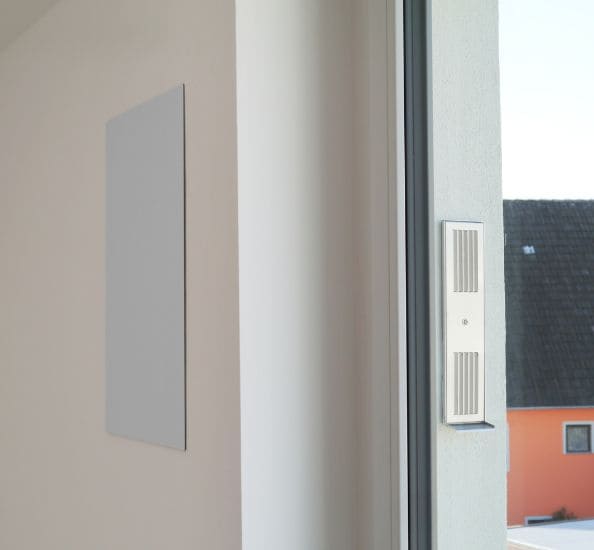
Visual requirements
To avoid detracting from the visual appearance of the facade, the designers and clients wanted to find a special solution that allowed the ventilation outlets to be integrated into the window reveal. Normally, the outdoor and exhaust air are drawn in and routed through adjacent air pipes which open directly onto the building facade. In Buckenhof, however, Meltem’s window reveal solution was used instead. Here, the outdoor and exhaust air are supplied through the window reveal, leaving the facade unaffected. An elegant stainless steel faceplate creates the external termination and is barely visible to the eye.
Summery
The Buckenhof residential complex shows that the room ventilation concept is now a fixed component of modern building fittings. The ease of installation and project-specific design enable it to be readily adapted to suit requirements. As well as meeting a high energy standard (the Buckenhof project meets the Passivhaus standard), Meltem comfort ventilation units contribute to a high air quality in the rooms. This in turn increases the feeling of wellness, especially in rooms that are occupied continuously.


